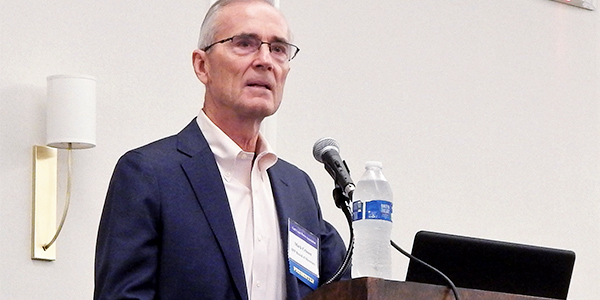NEW ORLEANS — Could this be the year SPP and MISO finally agree on an interregional transmission project?
Maybe. At least that’s what staff responsible for planning at the RTOs’ seam implied last week during a panel discussion at the Gulf Coast Power Association’s 7th annual MISO South Conference on Feb. 11.
An optimistic Casey Cathey, SPP’s manager of transmission planning and seams, assured a questioner that the grid operators will produce a coordinated system plan (CSP) this year. Two previous attempts have failed to yield an interregional project the organizations could agree on.
“We’re in heavy coordination and very close to coming up with some projects,” Cathey said. “For the first time in I don’t know how many years, we’ve got a good shot of getting a project through [the CSP].”
SPP’s desire for interregional projects has been driven by a wish to relieve congestion in eastern Kansas, which borders the MISO footprint. The growing impetus for MISO is the north-south transfer constraint between its Midwest and South regions.
As a result of a 2015 settlement agreement between the RTOs that also involves other parties, MISO is limited to 1,000 MW of contracted, firm transmission capacity between the two regions through SPP’s system, but it also has access to additional non-firm service capped at 3,000 MW in southbound flows and 2,500 MW northbound. (See SPP, MISO Reach Deal to End Transmission Dispute.)
Under the agreement, MISO pays SPP between $16 million and $38 million in base annual payments based on an annual available system capacity-usage factor. In February, that arrangement became subject to a 2 to 4% escalation rate. The limits also created problems during energy emergency alerts (EEAs) in 2018 and 2019, when MISO said the constraint prevented it from accessing resources to relieve the emergency.
With the agreement set to expire in February 2021, MISO is motivated to bring “operational certainty” to its members through new transmission projects or by purchasing additional firm capacity. (See MISO Floats New Option for Midwest-South Constraint.)
MISO Allocation Plan Fails on Local Project Treatment.)
“One of our objectives is to get to the point of long-term regional certainty,” said Jeremiah Doner, director of seams coordination for MISO.
“There will be another EEA event, with possible load shed,” Cooperative Energy COO Nathan Brown warned. “We really need some focus there.”
SPP could also be looking at its first international interregional project, Cathey said. The RTO shares a direct tie with Canada’s SaskPower through Basin Electric Power Cooperative’s existing transmission facilities in North Dakota and completed its first international transaction in 2015 when it imported power during an emergency situation. (See SPP, SaskPower Make First International Trade.)
A provision in SPP’s joint operating agreement with SaskPower allows joint planning analysis and coordinated system planning. With the oil-rich province of Saskatchewan facing continued load growth, SaskPower and SPP have held preliminary discussions.
“[SaskPower] can help fund projects in SPP and therefore improve their import capability,” Cathey said. “There are just so many things going on.”
Electric Industry Outpacing Others in Cybersecurity
SPP Director Mark Crisson opened a special briefing workshop GCPA held on the RTO by noting the growing importance of cybersecurity in the electric industry.
“Twelve years ago, this wasn’t on anyone’s radar,” he said. He recalled that when he became CEO of the American Public Power Association in 2007, he would receive “private, confidential” briefings from the Department of Homeland Security on industry cyber threats that were not to be shared with anyone else.
“It’s much more of an industry dialogue with the government now,” he said. “The nature of these threats evolve all the time. It’s hard to stay ahead of the bad guys, but it’s critical for our industry. We are way ahead of what other industries are doing, both with the steps we’re taking, the information we’re getting from the government, and the teamwork between us and the government.”
Crisson said SPP has developed its own set of cybersecurity criteria “that allows [us] to evaluate how effective or robust our cybersecurity really is.”
SPP currently scores itself above average, or between three and four on a five-point scale, Crisson said.
“We feel like we’re making good progress, but there’s a lot more to do here.”
Uncertainty Product a Key for SPP Reliability
The workshop mostly focused on the SPP Holistic Integrated Tariff Team’s work to integrate the growth of renewable energy, boost reliability, and improve transmission planning and the wholesale market. (See SPP Board Approves HITT’s Recommendations.)
Bill Grant, regional vice president of regulatory and strategic planning for Xcel Energy’s Southwestern Public Service, joined a panel of SPP members in explaining the HITT’s recommendation to develop an uncertainty product as “the art of dispatching.”
“We can handle the system a little differently if we have certainty,” said Grant, a former control center manager. “We have to develop tools for operators so they can react when there are any questions about the [generation] forecast.”
The HITT listed the uncertainty product as an “other reliability service,” which include new technologies that change the “underlying nature of grid operations that are not traditional operator tools.”
Grant pointed out that SPP’s market protocols and rules limit the flexibility dispatchers have to work with. However, the flexibility, or uncertainty product, is also needed as variable renewable generation takes a larger share of the fuel mix.
“Developing the uncertainty model will help us better learn about the market,” said Nebraska Public Power District’s Tom Kent, who chaired the HITT.
— Tom Kleckner




